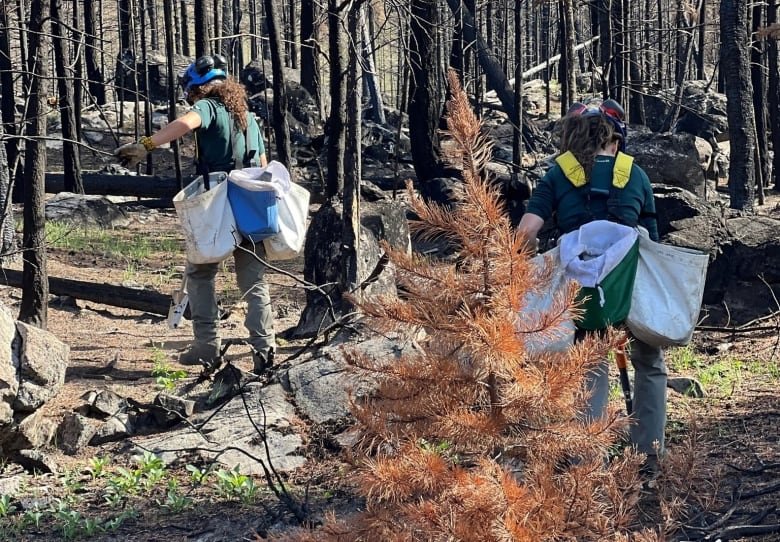It’s easy to spot contrasts in the forest landscape around Jasper National Park. Countless coniferous trees with thick, deep green branches line roads and mountainsides in areas spared from July’s wildfire.
Burned areas look barer, with the remains of charred branchless tree trunks.
There are signs of new life under the thin layer of snow now on the ground, but winter’s deep freeze will soon slow down any regrowth.
“The landscape, although really fragile, was greening up pretty quickly, which was kind of encouraging — a sign that there is still a seed base on the ground for things to happen,” said Marcia DeWandel, a Parks Canada vegetation restoration specialist.
The monster fire, the largest recorded in the park in over a century, is estimated to have burned more than 32,000 hectares.

Flames ignited early in the season, DeWandel said, so “we had a lot of our grasses, and our early succession and fire-adapted plants, come back right away.”
But it will take much longer for lost tree cover to be restored, she said.
Some trees and their roots were damaged so severely they will not grow back, she said, but others with sprawling root systems have a chance to regrow naturally.
“The tree will grow again from those little roots underneath the ground, as long as the fire didn’t go that deep,” DeWandel said. “This forest will change completely.
“Those fire-adapted species, like aspen and different willows and forbs [herbs other than grass] and grasses — they will come back first.”
5,000 new trees planted
Over the past two months, Parks Canada planted 5,000 Douglas fir seedlings in fire-damaged areas in Jasper National Park to supplement natural forest regrowth.

The tree species was chosen because of its adaptations, like thick bark and deep root systems, which make it better suited to withstand future wildfires. Over the next several years, Parks Canada also plans to plant aspen and willow trees.
The roots from the new trees will better hold fire-weakened soil together, helping prevent erosion, DeWandel said. Eroding soil is of particular concern near lakes and rivers, as sediment getting into the water can harm underwater ecosystems.
Tree planting efforts focused on areas near water and popular hiking and camping locations, because invasive plants could take over parts of the landscape, DeWandel said.
“With people moving on the landscape, they bring with them invasive species,” she said. “The wind also contributes to that, blowing the seeds around.”

Invasive alien species (IAS) are insects, plants, animals and fungi that were introduced to areas outside of their natural range. They can be carried on people’s shoes and gear by accident, according to Parks Canada.
Parks Canada officials say invasive species are the second-largest threat to biodiversity in the world, next to habitat loss. Getting trees in the ground before they get a foothold can help protect threatened ecosystems and wildlife.
Animals affected by forest canopy changes
Wild animals in Jasper National Park will have a harder time finding food this winter because of the reduced tree canopy, said James McCormick, a Parks Canada resource management officer.
Less tree cover allows more sun to hit the ground, which could be a good thing for animals who eat certain foods, like wild berries, McCormick said.
“Berry production is influenced by the amount of canopy. The more sun it gets, the more berries will get produced,” he said.
“Once the berries do start coming back in that burnt forest, we expect to get really higher crops than we have [had], historically, when the forest was present there.”

But fewer tree branches are blocking the ground, so snow, instead of piling up on tree branches, will hit the forest floor and bury any food that is growing back.
Bare forests also make it difficult for some animals to hide while hunting prey, McCormick said, and makes it more difficult for animals lower down on the food chain to hide from predators.
Due to food scarcity and safety, many animals are expected to move to unburned forest areas, which presents other challenges, he said.
“They may search out different areas than they normally would. It may increase the density of animals in certain areas, which may provide competition within the species itself,” said McCormick.
A decades-long renewal process
Although burned areas may not look like a traditional forest now, the landscape is supporting all kinds of biodiversity, said Ellen Macdonald, a retired forest ecology professor at the University of Alberta.

“It’s now a young forest. It’s going to be developing. There’s lots of other stuff there other than the trees,” she said.
As for when we could see charred sections looking like they once did, Macdonald said it could take decades.
“It’s going to take 40, 50 years to get to what we would really think of as big trees and full-grown trees,” she said.
“The kind of trees that were there before the fire, that’s going to be 100 years or more.”



